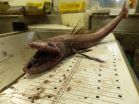(Press-News.org) An international team of scientists, led by astronomers at Queen Mary University of London, report of two new planets orbiting Kapteyn's star, one of the oldest stars found near the Sun. One of the newly-discovered planets could be ripe for life as it orbits at the right distance to the star to allow liquid water on its surface.
Discovered at the end of the 19th century and named after the Dutch astronomer who discovered it (Jacobus Kapteyn), Kapteyn's star is the second fastest moving star in the sky and belongs to the galactic halo, an extended cloud of stars orbiting our galaxy. With a third of the mass of the sun, this red-dwarf can be seen in the southern constellation of Pictor with an amateur telescope.
The astronomers used new data from HARPS[1]spectrometer at the ESO's La Silla observatory in Chile to measure tiny periodic changes in the motion of the star. Using the Doppler Effect, which shifts the star's light spectrum depending on its velocity, the scientists can work out some properties of these planets, such as their masses and periods of orbit.
The study also combined data from two more high-precision spectrometers to secure the detection: HIRES at Keck Observatory[2] and PFS at Magellan/Las Campanas Observatory[3].
"We were surprised to find planets orbiting Kapteyn's star. Previous data showed some moderate excess of variability, so we were looking for very short period planets when the new signals showed up loud and clear," explains lead author Dr Guillem Anglada-Escude, from QMUL's School of Physics and Astronomy.
Based on the data collected, the planet Kapetyn b is at least five times as massive as the Earth and it orbits the star every 48 days. This means the planet is warm enough for liquid water to be present on its surface. The second planet, Kapteyn c is a more massive super-Earth and quite different: its year lasts for 121 days and astronomers think it's too cold to support liquid water.
At the moment, only a few properties of the planets are known: approximate masses, orbital periods, and distances to the star. By measuring the atmosphere of these planets with next-generation instruments, scientists will try to find out whether they can bear water.
Typical planetary systems detected by NASA's Kepler mission are hundreds of light-years away. In contrast, Kapteyn's star is the 25th nearest star to the sun and it is only 13 light years away from Earth.
What makes this discovery different however, is the peculiar story of the star. Kapteyn's star was born in a dwarf galaxy absorbed and disrupted by the early Milky Way. Such galactic disruption event put the star in its fast halo orbit. The likely remnant core of the original dwarf galaxy is omega Centauri, an enigmatic globular cluster 16, 000 light years from earth which contains hundreds of thousands of similarly old suns. This sets the most likely age of the planets at 11.5 billion years; which is 2.5 times older than Earth and 'only' 2 billion years younger than the universe itself (around 13.7 billion years).
Dr Anglada-Escude adds: "It does make you wonder what kind of life could have evolved on those planets over such a long time."
Professor Richard Nelson, Head of the Astronomy Unit at QMUL, who didn't participate in the research, commented: "This discovery is very exciting. It suggests that many potentially habitable worlds will be found in the next years around nearby stars by ground-based and space-based observatories, such as PLATO. Until we have detected a larger number of them, the properties and possible habitability of the near-most planetary systems will remain mysterious."
INFORMATION:
Astronomers discover ancient worlds from another galaxy next door
2014-06-04
ELSE PRESS RELEASES FROM THIS DATE:
Iron, steel in hatcheries may distort magnetic 'map sense' of steelhead
2014-06-04
CORVALLIS, Ore. – Exposure to iron pipes and steel rebar, such as the materials found in most hatcheries, affects the navigation ability of young steelhead trout by altering the important magnetic "map sense" they need for migration, according to new research from Oregon State University.
The exposure to iron and steel distorts the magnetic field around the fish, affecting their ability to navigate, said Nathan Putman, who led the study while working as a postdoctoral researcher in the Department of Fisheries and Wildlife, part of OSU's College of Agricultural Sciences.
Just ...
Two planets orbit nearby ancient star
2014-06-04
Washington, D.C.— An international team of astronomers, including five Carnegie scientists, reports the discovery of two new planets orbiting a very old star that is near to our own Sun. One of these planets orbits the star at the right distance to allow liquid water to exist on its surface, a key ingredient to support life. Their work is published by Monthly Notices of the Royal Astronomical Society.
Kapteyn's Star, named after the Dutch astronomer, Jacobus Kapteyn, who discovered it at the end of the 19th century, is the second fastest-moving star in the sky and belongs ...
Deep sea fish remove 1 million tonnes of CO2 every year from UK and Irish waters
2014-06-04
Deep sea fishes remove and store more than one million tonnes of CO2 from UK and Irish surface waters every year, according to a new study led by the University of Southampton.
This natural carbon capture and storage scheme could store carbon equivalent to £10 million per year in carbon credits.
Fish living in deep waters on the continental slope around the UK play an important role carrying carbon from the surface to the seafloor.
It is assumed that deep water fishes all depend on particles that fall from the surface for their energy. These bottom-living deep water ...
The Lancet Psychiatry: Study shows increasing rates of premature death and violent crime in people with schizophrenia since 1970s
2014-06-04
New research, published in The Lancet Psychiatry journal, shows that rates of adverse outcomes, including premature death and violent crime, in people with schizophrenia are increasing, compared to the general population.
The results come from a unique study, led by Dr Seena Fazel, at Oxford University, UK, which analyses long-term adverse outcomes – including conviction for a violent crime (such as homicide or bodily harm) premature death (before the age of 56), and death by suicide – between 1972 and 2009 in nearly 25,000 people in Sweden diagnosed with schizophrenia ...
Pneumococcal conjugate vaccine is effective for preventing community-acquired pneumonia
2014-06-04
A 10-valent pneumococcal conjugate vaccine (PCV) is effective in reducing the number of new cases of likely-bacterial community-acquired pneumonia in infants in Latin America, according to a study published in this week's PLOS Medicine. Xavier Sáez-Llorens and colleagues from Department of Infectious Diseases, Panama found that the 10-valent PCV reduced the number of new cases of likely-bacterial community-acquired pneumonia in infants by 22% (95% CI: 7.7, 34.2) compared to those who received the control vaccine in the per-protocol cohort at the pre-planned interim analysis ...
Place and cause of death in centenarians: A population-based observational study in England
2014-06-04
Centenarians are more likely to die of pneumonia and frailty or "old age" and less likely to die of the chronic conditions often associated with old age, such as cancer or ischemic heart disease, compared with older adults younger than 100 years, according to a study by Catherine Evans and colleagues from King's College London, London, UK. Centenarians were most likely to die in a care home (61%) or hospital (27%) and less likely to die at home (10%) or in hospice care (0.2%). Higher care bed capacity was associated with fewer deaths of centenarians in hospital.
The ...
New health services needed for rise in 100-year-olds
2014-06-04
Over 35,000 people lived to 100 years or more in England over the last ten years, with a large proportion subsequently dying from frailty exacerbated by pneumonia, according to a new study by King's College London. With the number of centenarians set to grow, end-of-life care needs to be tailored to the increasing frailty in this age group, warn the King's palliative care researchers. Boosting care home capacity and planning health services for the rise in centenarians could help to reduce reliance on hospital admission at the end of life and ensure a better quality of ...
Unexpected diversity of egg yolk proteins play a key role in ant sociality and castes
2014-06-04
The social insects, including bees, wasps, ants and termites have developed a highly advanced society where division of labor amongst workers to serve the queen's reproduction has long fascinated biologists who have wanted to uncover the molecular pathways driving the complex behavior of insect societies.
In the advanced online edition of Molecular Biology and Evolution, Claire Morandin et al. performed molecular evolutionary analyses on the egg yolk forming protein, Vitellogenin (Vg), and its many forms, amongst seven Formica ant species. Vitellogenin is known to play ...
Discovering a hidden source of solar surges
2014-06-04
Cutting-edge observations with the 1.6-meter telescope at Big Bear Solar Observatory (BBSO) in California have taken research into the structure and activity of the Sun to new levels of understanding. Operated by New Jersey Institute of Technology (NJIT), the telescope at Big Bear is the most powerful ground-based instrument dedicated to studying the Sun.
A group of astronomers led by Dr. Santiago Vargas Domínguez has analyzed the highest- resolution solar observations ever made. A summary of their work at BBSO was presented on June 2 at the 224th meeting of the American ...
New device isolates most aggressive cancer cells
2014-06-04
ITHACA, N.Y. – Not all cancer cells are created equal – some stay put in the primary tumor, while others move and invade elsewhere. A major goal for cancer research is predicting which cells will metastasize, and why.
A Cornell cancer research team is taking a new approach to screening for these dangerous cells, using a microfluidic device they invented that isolates only the most aggressive, metastatic cells.
"The approach we've taken is a reverse approach from what is conventionally done," said Cynthia Reinhart-King, associate professor of biomedical engineering and ...


